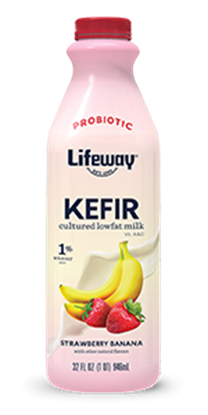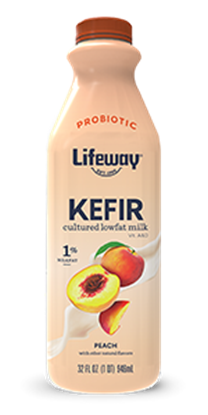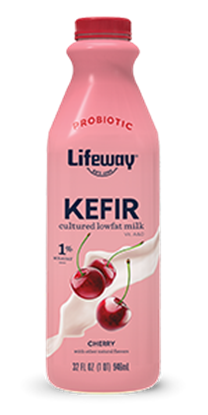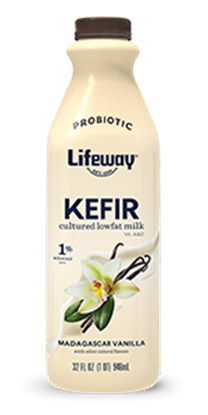You have no items in your shopping cart.
Kefir
Lifeway Low Fat Kefir Ban -Strawberry
Our most popular product line, Lifeway Lowfat Kefir is up to 99% lactose-free, gluten-free, and made with all natural, non-GMO ingredients. Kefir is a tart and tangy cultured dairy drink packed with protein, calcium, and 12 live and active probiotic cultures.
Lifeway’s Strawberry Banana Low fat Kefir is lightly sweetened with 1g of added cane sugar per ounce. Blend into a smoothie, whip into a dip, or simply pour yourself a glass! After all, it is the Champagne of Dairy.
INGREDIENTS
Pasteurized Cultured Lowfat Milk, Nonfat Milk, Cane Sugar, Pectin, Natural Banana Flavor, Natural Strawberry Flavor, Natural Flavors, Red Beet Juice (for Color), Vitamin A Palmitate, Vitamin D3.
Lifeway Low Fat Kefir Raspberry
Low Fat Raspberry
Our most popular product line, Lifeway Lowfat Kefir is up to 99% lactose-free, gluten-free, and made with all natural, non-GMO ingredients. Kefir is a tart and tangy cultured dairy drink packed with protein, calcium, and 12 live and active probiotic cultures.
Lifeway’s Raspberry Low fat Kefir is lightly sweetened with 1g of added cane sugar per ounce. Blend into a smoothie, whip into a dip, or simply pour yourself a glass! After all, it is the Champagne of Dairy.
INGREDIENTS
Pasteurized Cultured Lowfat Milk, Nonfat Milk, Cane Sugar, Pectin, Natural Raspberry Flavor, Natural Flavors, Red Beet Juice (for Color), Vitamin A Palmitate, Vitamin D3.
PROBIOTIC CULTURES:
Lifeway Low Fat Kefir Peach
Low Fat Kefir Peach
Our most popular product line, Lifeway Lowfat Kefir is up to 99% lactose-free, gluten-free, and made with all natural, non-GMO ingredients. Kefir is a tart and tangy cultured dairy drink packed with protein, calcium, and 12 live and active probiotic cultures.
Lifeway’s Peach Lowfat Kefir is lightly sweetened with 1g of added cane sugar per ounce. Blend into a smoothie, whip into a dip, or simply pour yourself a glass! After all, it is the Champagne of Dairy.
INGREDIENTS
Pasteurized Cultured Lowfat Milk, Nonfat Milk, Cane Sugar, Pectin, Natural Peach Flavor, Natural Flavors, Annatto Extract (For Color), Vitamin A Palmitate, Vitamin D3.
Lifeway Low Fat Kefir Cherry 32 oz
Low Fat Kefir Cherry 32 oz
Our most popular product line, Lifeway Lowfat Kefir is up to 99% lactose-free, gluten-free, and made with all natural, non-GMO ingredients. Kefir is a tart and tangy cultured dairy drink packed with protein, calcium, and 12 live and active probiotic cultures.
Lifeway’s Cherry Lowfat Kefir is lightly sweetened with 1g of added cane sugar per ounce. Blend into a smoothie, whip into a dip, or simply pour yourself a glass! After all, it is the Champagne of Dairy
INGREDIENTS
Pasteurized Cultured Lowfat Milk, Nonfat Milk, Cane Sugar, Pectin, Natural Cherry Flavor, Natural Flavors, Red Beet Juice For Color, Vitamin A Palmitate, Vitamin D3.
Lifeway Low Fat Kefir Blueberry
Low Fat Kefir Blueberry
Our most popular product line, Lifeway Lowfat Kefir is up to 99% lactose-free, gluten-free, and made with all natural, non-GMO ingredients. Kefir is a tart and tangy cultured dairy drink packed with protein, calcium, and 12 live and active probiotic cultures.
Lifeway’s Blueberry Lowfat Kefir is lightly sweetened with 1g of added cane sugar per ounce. Blend into a smoothie, whip into a dip, or simply pour yourself a glass! After all, it is the Champagne of Dairy.
INGREDIENTS
Pasteurized Cultured Lowfat Milk, Nonfat Milk, Cane Sugar, Pectin, Natural Blueberry Flavor, Natural Flavors, Grape Juice (For Color), Vitamin A Palmitate, Vitamin D3.
Lifeway Low Fat Kefir Vanilla
Low Fat Kefir Vanilla 32 oz
MADAGASCAR VANILLA
Our most popular product line, Lifeway Lowfat Kefir is up to 99% lactose-free, gluten-free, and made with all natural, non-GMO ingredients. Kefir is a tart and tangy cultured dairy drink packed with protein, calcium, and 12 live and active probiotic cultures.
Lifeway’s Madagascar Vanilla Lowfat Kefir is lightly sweetened with 1g of added cane sugar per ounce. Blend into a smoothie, whip into a dip, or simply pour yourself a glass! After all, it is the Champagne of Dairy.
NGREDIENTS
Pasteurized Cultured Lowfat Milk, Nonfat Milk, Cane Sugar, Pectin, Natural Vanilla Flavor, Natural Flavors, Vitamin A Palmitate, Vitamin D3.

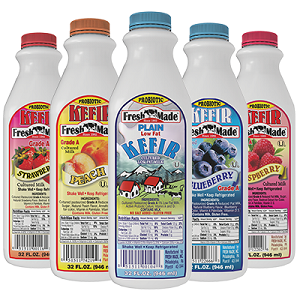 Kefir was discovered in ancient times, when nomadic shepherds in the Caucasus Mountains of Eastern Europe found that the milk they carried in leather sacks occasionally fermented into a creamy, bubbly drink. Its tart and refreshing flavor is often compared to yogurt. The difference is, Kefir is drinkable and it contains many more of the friendly bacteria known as “probiotics.”
Kefir was discovered in ancient times, when nomadic shepherds in the Caucasus Mountains of Eastern Europe found that the milk they carried in leather sacks occasionally fermented into a creamy, bubbly drink. Its tart and refreshing flavor is often compared to yogurt. The difference is, Kefir is drinkable and it contains many more of the friendly bacteria known as “probiotics.”